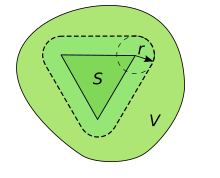Neighbourhood (mathematics)

A set V{displaystyle V}
 in the plane is a neighbourhood of a point p{displaystyle p}
in the plane is a neighbourhood of a point p{displaystyle p} if a small disc around p{displaystyle p}
if a small disc around p{displaystyle p} is contained in V{displaystyle V}
is contained in V{displaystyle V} .
.In topology and related areas of mathematics, a neighbourhood (or neighborhood) is one of the basic concepts in a topological space. It is closely related to the concepts of open set and interior. Intuitively speaking, a neighbourhood of a point is a set of points containing that point where one can move some amount in any direction away from that point without leaving the set.
Contents
1 Definitions
1.1 Neighbourhood of a point
1.2 Neighbourhood of a set
2 In a metric space
3 Examples
4 Topology from neighbourhoods
5 Uniform neighbourhoods
6 Deleted neighbourhood
7 See also
8 References
Definitions
Neighbourhood of a point
If X{displaystyle X}







- p∈U⊆V.{displaystyle pin Usubseteq V.}
This is also equivalent to p∈X{displaystyle pin X}

Note that the neighbourhood V{displaystyle V}


A rectangle is not a neighbourhood of any of its corners (or points on the boundary).
A set that is a neighbourhood of each of its points is open since it can be expressed as the union of open sets containing each of its points. A rectangle, as illustrated in the figure, is not a neighbourhood of all its points; points on the edges or corners of the rectangle are not contained in any open set that is contained within the rectangle.
The collection of all neighbourhoods of a point is called the neighbourhood system at the point.
Neighbourhood of a set
If S{displaystyle S}












In a metric space

A set S{displaystyle S}
 in the plane and a uniform neighbourhood V{displaystyle V}
in the plane and a uniform neighbourhood V{displaystyle V} of S{displaystyle S}
of S{displaystyle S} .
.The epsilon neighbourhood of a number a on the real number line.
In a metric space M=(X,d){displaystyle M=(X,d)}




- Br(p)=B(p;r)={x∈X∣d(x,p)<r}{displaystyle B_{r}(p)=B(p;r)={xin Xmid d(x,p)<r}}
is contained in V{displaystyle V}
V{displaystyle V}




- Br(p)={x∈X∣d(x,p)<r}{displaystyle B_{r}(p)={xin Xmid d(x,p)<r}}
is contained in V{displaystyle V}
For r>0{displaystyle r>0}










It directly follows that an r{displaystyle r}


Examples
The set M is a neighbourhood of the number a, because there is an ε-neighbourhood of a which is a subset of M.
Given the set of real numbers R{displaystyle mathbb {R} }

- V:=⋃n∈NB(n;1/n),{displaystyle V:=bigcup _{nin mathbb {N} }Bleft(n,;,1/nright),}
then V{displaystyle V}

Topology from neighbourhoods
The above definition is useful if the notion of open set is already defined. There is an alternative way to define a topology, by first defining the neighbourhood system, and then open sets as those sets containing a neighbourhood of each of their points.
A neighbourhood system on X{displaystyle X}




- the point x{displaystyle x}
is an element of each U{displaystyle U}
in N(x){displaystyle N(x)}
- each U{displaystyle U}
in N(x){displaystyle N(x)}
contains some V{displaystyle V}
in N(x){displaystyle N(x)}
such that for each y{displaystyle y}
in V{displaystyle V}
, U{displaystyle U}
is in N(y){displaystyle N(y)}
.
One can show that both definitions are compatible, i.e. the topology obtained from the neighbourhood system defined using open sets is the original one, and vice versa when starting out from a neighbourhood system.
Uniform neighbourhoods
In a uniform space S=(X,δ){displaystyle S=(X,delta )}






Deleted neighbourhood
A deleted neighbourhood of a point p{displaystyle p}






See also
- Tubular neighbourhood
References
^ Dixmier, Jacques (1984). General Topology. Undergraduate Texts in Mathematics. Translated by Sterling K. Berberian. Springer. p. 6. ISBN 0-387-90972-9.According to this definition, an open neighborhood of x is nothing more than an open subset of E that contains x.
.mw-parser-output cite.citation{font-style:inherit}.mw-parser-output q{quotes:"""""""'""'"}.mw-parser-output code.cs1-code{color:inherit;background:inherit;border:inherit;padding:inherit}.mw-parser-output .cs1-lock-free a{background:url("//upload.wikimedia.org/wikipedia/commons/thumb/6/65/Lock-green.svg/9px-Lock-green.svg.png")no-repeat;background-position:right .1em center}.mw-parser-output .cs1-lock-limited a,.mw-parser-output .cs1-lock-registration a{background:url("//upload.wikimedia.org/wikipedia/commons/thumb/d/d6/Lock-gray-alt-2.svg/9px-Lock-gray-alt-2.svg.png")no-repeat;background-position:right .1em center}.mw-parser-output .cs1-lock-subscription a{background:url("//upload.wikimedia.org/wikipedia/commons/thumb/a/aa/Lock-red-alt-2.svg/9px-Lock-red-alt-2.svg.png")no-repeat;background-position:right .1em center}.mw-parser-output .cs1-subscription,.mw-parser-output .cs1-registration{color:#555}.mw-parser-output .cs1-subscription span,.mw-parser-output .cs1-registration span{border-bottom:1px dotted;cursor:help}.mw-parser-output .cs1-hidden-error{display:none;font-size:100%}.mw-parser-output .cs1-visible-error{font-size:100%}.mw-parser-output .cs1-subscription,.mw-parser-output .cs1-registration,.mw-parser-output .cs1-format{font-size:95%}.mw-parser-output .cs1-kern-left,.mw-parser-output .cs1-kern-wl-left{padding-left:0.2em}.mw-parser-output .cs1-kern-right,.mw-parser-output .cs1-kern-wl-right{padding-right:0.2em}
Kelley, John L. (1975). General topology. New York: Springer-Verlag. ISBN 0-387-90125-6.
Bredon, Glen E. (1993). Topology and geometry. New York: Springer-Verlag. ISBN 0-387-97926-3.
Kaplansky, Irving (2001). Set Theory and Metric Spaces. American Mathematical Society. ISBN 0-8218-2694-8.




